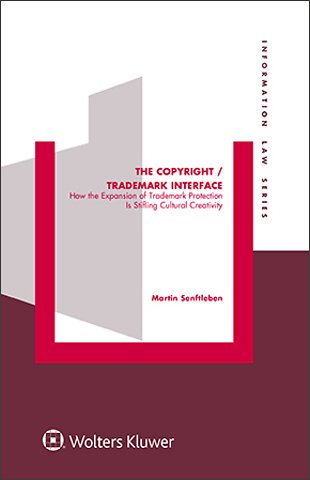The Copyright/Trademark Interface
How the Expansion of Trademark Protection Is Stifling Cultural Creativity
Samenvatting
Information Law Series Volume 44
The Copyright/Trademark Interface is an exceptional analysis of the clash between culture and commerce, and the imbalances caused by protection overlaps arising from cumulative copyright and trademark protection. This book highlights the corrosive effect of indefinitely renewable trademark rights. It underscores the necessity to safeguard central preconditions for the proper functioning of the copyright system in society at large: the freedom to use pre-existing works as reference points for the artistic discourse and building blocks for new creations need to ensure the constant enrichment of the public domain. The registration of cultural icons as trademarks has become a standard protection strategy in contemporary cultural productions. It plays an augmented role in the area of cultural heritage. Attempts to register and ‘evergreen’ the protection of cultural signs, ranging from ‘Mickey Mouse’ to the ‘Mona Lisa’, are no longer unusual. This phenomenon, which is characterized by the EFTA Court as trademark registrations and is triggered by ‘commercial greed’, has become typical of an era where trademark law is employed strategically to restrain or eliminate cultural symbols from the public domain.
What’s in this book:
By drawing attention to how overlapping copyright and trademark protection imperils the proper functioning of intellectual property rights in the literary and artistic domain, the author delves into whether the intellectual property system can mitigate the risks arising from cumulative protection. The issues and topics explored in depth are:
- the different configuration of intellectual property rights following different policy objectives and societal functions, in particular, the cultural imperative in copyright law and the market transparency imperative in trademark law;
- problems arising from the registration of cultural icons for use on souvenir and merchandising articles;
- lack of sufficient safeguards in trademark law against cultural heritage branding;
- current scope of trademark rights, including the protection of brand value and communication functions, and the deterrent effect of trademark protection on cultural creativity;
- possibility of a categorical exclusion of contemporary cultural icons and cultural heritage material from trademark protection;
- development of a strict gatekeeper requirement of ‘use as a mark’ to prevent unjustified trademark infringement claims;
- development of robust, culturally based defences against trademark infringement claims; and
- general guidelines for the regulation of protection overlaps in intellectual property law, based on insights derived from the analysis of copyright/trademark overlaps.
How this will help you:
Drawing on aesthetic, sociological and economic theories that support initiatives to safeguard the autonomy of the literary and artistic domain and support the remix activities of artists, the author suggests sound criteria for identifying signs with cultural significance that should be excluded from trademark registration. The book shows how intellectual property law can make rights cumulation strategies less attractive and avoid the loss of inner consistency and social legitimacy, easing the tension between indefinitely renewable trademark rights and the need to preserve and cultivate the public domain of cultural expressions and other intellectual creations that enjoy protection for a limited period of time, such as industrial designs and technical know-how. Its assessment criteria will assist and enable trademark examiners and judges to identify relevant cultural signs. Its proposals for regulatory responses to protection overlaps in intellectual property law will prove to be of great and lasting value to lawyers, policymakers, and scholars dealing with intellectual property law.
Specificaties
Inhoudsopgave
List of Abbreviations
Chapter 1
Introduction
Chapter 2
Overlap Dilemma
Chapter 3
Cultural Imperative in Copyright Law
Chapter 4
Market Transparency Imperative in Trademark Law
Chapter 5
Cultural Signs to Be Kept Free
Chapter 6
Risk Assessment
Chapter 7
Perpetuation of the Protection of Cultural Expressions
Chapter 8
Reappropriation of Cultural Expressions in the Public Domain
Chapter 9
Risk Reduction
Chapter 10
Overlap Dilemma Revisited
Bibliography
Table of Cases
Index
Anderen die dit boek kochten, kochten ook
Net verschenen
Rubrieken
- aanbestedingsrecht
- aansprakelijkheids- en verzekeringsrecht
- accountancy
- algemeen juridisch
- arbeidsrecht
- bank- en effectenrecht
- bestuursrecht
- bouwrecht
- burgerlijk recht en procesrecht
- europees-internationaal recht
- fiscaal recht
- gezondheidsrecht
- insolventierecht
- intellectuele eigendom en ict-recht
- management
- mens en maatschappij
- milieu- en omgevingsrecht
- notarieel recht
- ondernemingsrecht
- pensioenrecht
- personen- en familierecht
- sociale zekerheidsrecht
- staatsrecht
- strafrecht en criminologie
- vastgoed- en huurrecht
- vreemdelingenrecht







